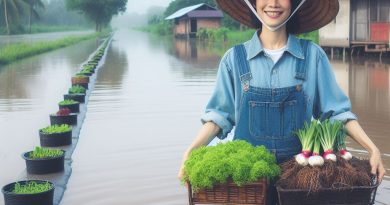Climate Challenges: Diversify Crops, Secure Future
Last Updated on March 5, 2024
Introduction
Climate change is posing significant challenges to agriculture, making it crucial to diversify crops for a more secure future.
The fate of our food supply depends on it.
In today’s world, it is essential to address the issue of climate change and its detrimental effects on agriculture.
With rising temperatures, changing precipitation patterns, and increased frequency of extreme weather events, the agricultural sector faces numerous challenges.
To ensure food security for future generations, we must take proactive measures to adapt and mitigate the impacts of climate change.
One key strategy to tackle these challenges is diversifying crops.
Traditional agricultural practices have favored monocultures, where farmers grow a narrow range of crops in large quantities.
While this approach may have served us well in the past, it leaves our food supply vulnerable to climate-related disruptions.
By diversifying crops, we can enhance resilience and reduce the risks associated with climate change.
Planting a variety of crops on the same farm can safeguard against extreme weather events that may favor certain crops over others.
Additionally, diverse crops help maintain biodiversity and soil health, ensuring sustainable agricultural practices for years to come.
Moreover, diversification can offer economic benefits to farmers.
By cultivating a wider range of crops, farmers can tap into new markets and reduce their dependence on a single commodity.
This diversification can provide a safety net during times of market volatility and ensure a more stable income for farmers.
In fact, the need to diversify crops in response to climate challenges is undeniable.
By embracing diversity in agriculture, we can safeguard our food supply, enhance resilience, and promote sustainable farming practices.
It is vital for governments, farmers, and consumers to work together to prioritize and support agricultural diversification for a more secure future.
The time to act is now.
The Impact of Climate Change on Agriculture
Climate change is rapidly affecting and will continue to affect agricultural practices around the world.
Farmers are facing numerous challenges as a result, including extreme weather events, prolonged droughts, and changing rainfall patterns, all of which directly impact crop production and overall food security.
Extreme Weather Events
Extreme weather events, such as hurricanes, floods, and heatwaves, have become more frequent and intense due to climate change.
These events damage crops, destroy infrastructure, and disrupt agricultural systems, leading to significant losses for farmers.
Prolonged Droughts
Changing climate patterns have resulted in prolonged droughts in many regions, making it difficult for farmers to cultivate crops.
Limited water availability reduces crop yield, negatively impacting food production and putting food security at risk.
Changing Rainfall Patterns
Climate change has also led to unpredictable and shifting rainfall patterns.
Alterations in the timing and amount of rainfall affect planting, growth, and harvest seasons, making it challenging for farmers to plan and manage their agricultural activities efficiently.
Crop Yield Reduction
The combination of extreme weather events, prolonged droughts, and shifting rainfall patterns ultimately results in reduced crop yields.
Crop failures lead to significant economic losses for farmers, affecting their livelihoods and food availability for the local population.
Increased Pests and Diseases
Climate change creates favorable conditions for pests and diseases, causing outbreaks that further harm crop production.
Insects and pathogens thrive in warmer temperatures and altered ecosystems, leading to increased pesticide use and reduced crop quality.
Loss of Biodiversity
Climate change disrupts ecosystems and reduces biodiversity, negatively impacting pollinators and essential organisms for crop production.
The decline in pollinators, such as bees, threatens the reproduction of many crops, further endangering food security.
Shifts in Agricultural Zones
As temperatures rise, the suitable zones for various crops shift, requiring adjustments in farming practices and potentially leading to the displacement of certain crops.
Relocating or adapting to these changes poses significant challenges for farmers.
Water Management Challenges
With changing rainfall patterns and increased droughts, water management becomes critically important.
Farmers must invest in irrigation systems, water conservation techniques, and efficient water usage practices to sustain crop production amidst limited water resources.
Economic Vulnerability for Farmers
The cumulative impacts of climate change on agriculture increase the economic vulnerability of farmers.
Crop losses, increased production costs, and the need for adaptation measures strain their finances, posing a significant threat to their livelihoods and future sustainability.
Food Insecurity
Ultimately, the challenges imposed by climate change on agriculture directly affect overall food security.
Reduced crop yields, crop failures, and increased food prices can lead to food shortages and malnutrition, particularly in vulnerable regions heavily reliant on agriculture.
In short, climate change poses significant challenges to agriculture, with implications for farmers and global food security.
Steps must be taken at both individual and governmental levels to mitigate these challenges, such as investing in climate-resilient farming practices, implementing sustainable water management strategies, and supporting farmers in adapting to changing conditions.
Failure to address the impact of climate change on agriculture could have dire consequences for the future of food production and the well-being of communities worldwide.
Read: Protecting Soil in a Warmer World
The Importance of Crop Diversification
Crop diversification is the practice of growing a wider variety of crops on a farm, rather than relying on a single crop.
It is a crucial strategy in addressing climate challenges and ensuring the security of our future.
The significance of crop diversification in addressing climate challenges
Climate change poses numerous challenges to agriculture, such as extreme weather events, changing rainfall patterns, and rising temperatures.
These challenges can lead to crop failures, reduced yields, and increased vulnerability for farmers.
Crop diversification plays a vital role in helping farmers adapt to these changing climatic conditions.
By planting a variety of crops, farmers increase their chances of having a successful harvest even in the face of unfavorable weather conditions.
If one crop fails, there are others that can still thrive.
This resilience to climate change is possible because different crops have different temperature and moisture requirements.
By diversifying their crops, farmers can mitigate the risks associated with uncertain weather patterns.
Moreover, crop diversification helps maintain soil health.
Growing the same crop repeatedly can deplete the soil of specific nutrients and increase the risk of pests and diseases.
Introducing different crops breaks this cycle, as each crop has unique nutrient requirements and can help replenish the soil.
This reduces the need for synthetic fertilizers and pesticides, making farming more sustainable.
Benefits of crop diversification
- Reduced vulnerability to pests and diseases: Monocultures are more susceptible to devastating pest outbreaks. Diverse cropping systems create a less favorable environment for pests and diseases to thrive.
- Improved soil health: Different crops have different root structures and nutrient requirements. This diversity helps improve soil structure, nutrient cycling, and organic matter content.
- Enhanced ecosystem resilience: Crop diversification promotes biodiversity by creating diverse habitats for pollinators, beneficial insects, and other wildlife. This strengthens the overall resilience of the ecosystem.
- Increased market opportunities: Diversifying crops enables farmers to cater to various market demands. They can take advantage of niche markets and fluctuating prices, reducing dependency on a single crop.
- Long-term sustainability: By reducing reliance on synthetic inputs like fertilizers and pesticides, crop diversification contributes to a more sustainable agricultural system. It helps preserve soil quality and minimizes the impact on water resources.
In essence, crop diversification is a critical tool in addressing climate challenges and securing our future.
By diversifying crops, farmers can adapt to changing climatic conditions, reduce vulnerability to pests and diseases, improve soil health, and enhance ecosystem resilience.
Unlocking the potential of crop diversification requires supporting farmers with adequate knowledge, resources, and policies that promote sustainable agriculture.
Read: Cover Crops: Heroes in Climate Battle

Promising Diversification Strategies
Farmers face numerous challenges in adapting to the changing climate.
One of the key strategies to ensure a secure future is to diversify crops.
By adopting various crop diversification strategies, farmers can not only improve their resilience but also contribute to sustainable food production.
Rotating Crops: Improving Soil Fertility and Reducing Pest Pressure
One effective strategy is crop rotation, which involves the systematic sequencing of different crops on the same piece of land over time.
This practice helps to enhance soil fertility and reduce the buildup of pests and diseases.
Crop rotation works by disrupting pest and disease cycles. Different crops have different nutrient requirements, which affect the soil differently.
By rotating crops, farmers can create a diverse soil environment that is less favorable for pests and diseases to thrive.
For example, alternating between legumes and cereal crops can enhance nitrogen fixation and improve soil structure.
Legumes have the ability to fix atmospheric nitrogen, which can be utilized by subsequent crops in the rotation.
This reduces the need for synthetic fertilizers and results in cost savings for farmers.
Furthermore, crop rotation can also break the lifecycle of pests and diseases.
Some pests have specific crop preferences, and by rotating crops, farmers can reduce the abundance of these pests.
This reduces the reliance on chemical pesticides, resulting in a more environmentally friendly farming system.
Intercropping: Maximizing Land Utilization and Minimizing Pest and Disease Outbreaks
Another diversification strategy is intercropping. Intercropping involves growing two or more crops simultaneously in the same field.
This practice can lead to several benefits that contribute to climate resilience.
Firstly, intercropping maximizes land utilization.
By growing complementary crops together, farmers can make the most efficient use of limited land resources.
For example, planting a nitrogen-fixing crop alongside a cash crop not only increases overall production but also improves soil fertility.
Secondly, intercropping can minimize pest and disease outbreaks.
By planting different crops together, pests and diseases that specialize in a specific crop can be deterred.
The diversity of crops also promotes beneficial insect populations, which can assist in natural pest control.
Intercropping practices can range from simple mixtures of crops to more complex agroforestry systems.
Agroforestry systems involve the integration of trees with agricultural crops, providing additional benefits such as shade, windbreak, and enhanced biodiversity.
Exploring Non-Traditional Crops: Better Suitability to the Changing Climate
In addition to crop rotation and intercropping, exploring non-traditional crops is crucial for climate resilience.
As the climate continues to change, certain crops may become less viable while others may thrive.
Non-traditional crops refer to those that are not commonly grown in a particular region but have the potential to thrive under changing climatic conditions.
These crops often have specific traits that make them more resilient to extreme temperatures, water scarcity, or pests and diseases.
By diversifying crop selections, farmers can tap into new market opportunities and reduce their reliance on a single crop.
This improves their resilience to climate-related shocks, such as droughts or sudden changes in temperature.
In review, diversifying crops is an essential strategy in addressing climate challenges.
By adopting crop rotation, intercropping, and exploring non-traditional crops, farmers can secure a brighter future.
These strategies not only improve soil fertility, minimize pest pressure, and maximize land utilization but also enhance overall resilience to the ever-changing climate.
Read: Climate Change: Its Effects on Soil Health
Obstacles and Solutions in Crop Diversification
Potential barriers for farmers to adopt crop diversification practices
When it comes to crop diversification, farmers may encounter several obstacles that hinder their adoption of new practices.
These barriers can range from financial constraints to a lack of knowledge and resistance to change.
However, there are also various solutions available to help farmers overcome these challenges and embrace crop diversification as a sustainable farming method.
Financial constraints, lack of knowledge, and resistance to change as common obstacles
Financial constraints often discourage farmers from implementing crop diversification practices.
The initial investment required to diversify crops can be significant, including costs for acquiring new seeds, equipment, and infrastructure.
Additionally, shifting from a monoculture system to one that involves multiple crops can result in temporary income reductions, further exacerbating financial strain for farmers.
To address these financial hurdles, government support programs can play a crucial role.
Governments can offer subsidies or grants to farmers to help offset the costs associated with adopting crop diversification.
These financial incentives can alleviate some of the burdens and encourage more farmers to explore this sustainable agricultural practice.
Another key obstacle to crop diversification is the lack of knowledge and information among farmers.
Traditional farming methods have been deeply ingrained in many agricultural communities, and introducing new crops can be met with resistance.
Farmers may hesitate to try something unfamiliar due to a lack of understanding about the potential benefits and risks.
To overcome this barrier, farmer education initiatives become essential.
Agricultural extension services can provide training and workshops to educate farmers about the advantages of crop diversification, including improved resilience to climate change, reduced pest and disease pressure, and enhanced soil health.
By enhancing farmers’ knowledge and awareness, they can feel more confident in embracing crop diversification.
Resistance to change is yet another obstacle that farmers face when considering crop diversification.
Humans are naturally resistant to change, and farmers are no exception. Moving away from established practices can be daunting, especially when there is uncertainty about the outcomes.
The fear of failure and the unfamiliarity of new crops can deter farmers from taking risks.
Potential solutions like government support programs, farmer education initiatives, and research and development efforts
To address this resistance, research and development efforts are crucial.
Investing in robust research programs that focus on developing crop varieties suitable for diverse climates and introducing innovative farming techniques can build confidence among farmers.
Demonstrating the benefits of crop diversification through field trials and showcasing success stories can help overcome the resistance to change and encourage more farmers to embrace this practice.
Therefore, while there are obstacles that hinder farmers from adopting crop diversification practices, there are also viable solutions available.
Government support programs, farmer education initiatives, and research and development efforts can all contribute to breaking down these barriers.
By addressing financial constraints, improving knowledge, and addressing resistance to change, crop diversification can be promoted as a sustainable and profitable farming method.
Through these collective efforts, farmers can secure a more resilient and prosperous future for themselves and contribute to mitigating climate challenges.
Read: Adapting Farming to Climate Shifts
Delve into the Subject: Crops vs. Climate: Diversity for Stability
Case Studies of Successful Crop Diversification
In the face of climate challenges, crop diversification has emerged as a promising strategy for farmers to secure a sustainable future.
This blog section aims to highlight real-life examples and success stories of farmers who have successfully implemented crop diversification.
By examining the challenges they faced and the strategies they used, we can understand the positive outcomes they achieved in terms of increased resilience, improved yields, and economic stability.
Farmers Who Implemented Crop Diversification
- The Johnson family, located in the Midwest, faced frequent droughts that severely impacted their corn yield. To mitigate this risk, they diversified their crops by introducing soybeans and wheat into their rotation. Not only did this help distribute their risk, but it also led to increased soil health and improved water retention.
- In California, the Smiths were struggling with increasing instances of pests and diseases in their vineyard. They decided to incorporate cover crops and intercropping techniques to attract beneficial insects and increase biodiversity. As a result, they witnessed a significant reduction in pest damage and a decrease in the need for chemical inputs.
- In India, the Patel brothers were facing water scarcity and decreasing groundwater levels due to erratic rainfall patterns. They switched to cultivating drought-tolerant crops such as millets and pulses, which required less water. This not only conserved water but also provided them with resilient harvests during periods of drought.
Challenges Faced and Strategies Used
- The Johnsons faced initial skepticism about venturing into new crops and markets. However, they overcame this challenge by conducting thorough research, attending trainings, and seeking guidance from agricultural experts. This helped them gain confidence in their decisions and adapt to the demands of new crops.
- For the Smiths, the biggest challenge was convincing buyers to accept the diversification of their vineyard crops. To address this, they started by selling their diversified produce to local markets and participating in farmers’ markets. Through these efforts, they successfully educated consumers about the benefits of diversified crops and eventually gained wider acceptance.
- The Patel brothers faced resistance from traditional farming communities who were skeptical of the profitability of drought-tolerant crops. They tackled this challenge by organizing field demonstrations and sharing their success stories with neighboring farmers. Eventually, other farmers began to recognize the benefits and adopted similar diversification strategies.
Positive Outcomes Achieved
- The Johnson family witnessed increased resilience in their farming system. As a result of crop diversification, they experienced reduced financial losses during periods of drought. Additionally, the introduction of soybeans and wheat improved their overall yields and provided them with alternative income sources.
- The Smiths successfully managed to control pests and diseases without relying heavily on chemical inputs. This not only saved them costs but also improved the ecological balance of their vineyard. The increased biodiversity resulting from crop diversification also enhanced pollination, leading to better grape production.
- For the Patel brothers, diversifying their crops proved to be a game-changer. They were able to cope with water scarcity and ensure a continuous harvest by cultivating drought-tolerant crops. As a result, their economic stability improved, and they became role models for other farmers facing similar challenges.
In a nutshell, these case studies provide concrete evidence of the benefits of crop diversification in the face of climate challenges.
By diversifying their crops, farmers can increase resilience in their farming systems, improve yields, and attain economic stability.
However, it is essential to recognize and address the challenges associated with crop diversification to ensure its successful implementation.
By learning from these success stories, other farmers can be encouraged and inspired to embark on a similar path towards a sustainable and secure future.
Conclusion
The diversification of crops plays a vital role in addressing climate challenges.
By expanding the range of crops grown, farmers can reduce their reliance on a single crop, which helps mitigate the risks associated with changing weather patterns and disease outbreaks.
Furthermore, diversifying crops benefits both farmers and the environment.
It allows farmers to adapt to climate variations and market demands, thus increasing their resilience and economic stability.
Additionally, diverse cropping systems enhance soil health, conserve water, promote biodiversity, and reduce the need for synthetic inputs, creating a more sustainable agricultural ecosystem.
It is crucial for readers to take action by supporting and implementing crop diversification practices on their farms or in their communities.
By doing so, we can ensure a secure agricultural future and reduce the vulnerability of our food systems in the face of climate change.
Supporting local farmers who practice crop diversification, buying a variety of locally grown produce, and advocating for policies that incentivize diversification are impactful ways to contribute.
Additionally, individuals can educate themselves about the benefits of diverse cropping systems and share this knowledge with others.
Implementing crop diversification practices is not only essential for food security but also for the sustainability of our planet.
Every action counts in creating a resilient and climate-smart agricultural sector, and each individual has the power to drive this positive change.


